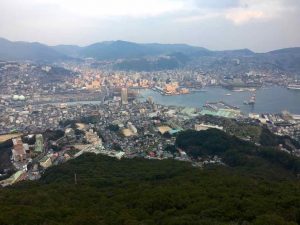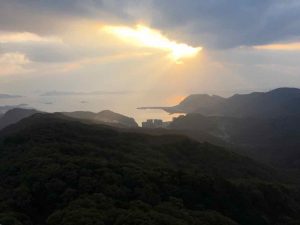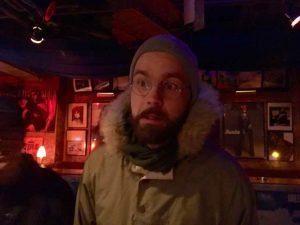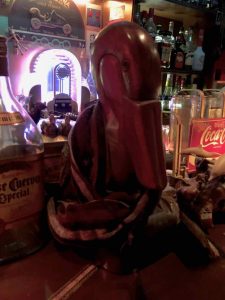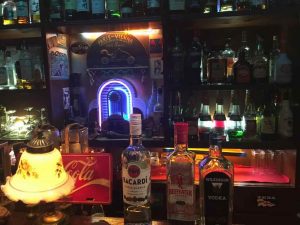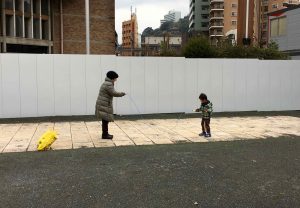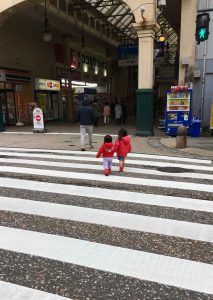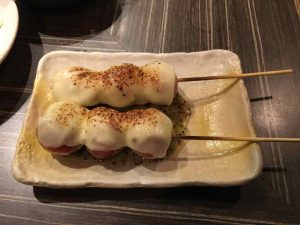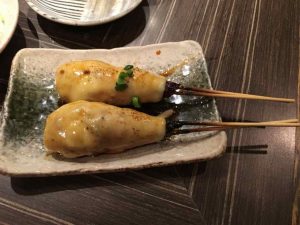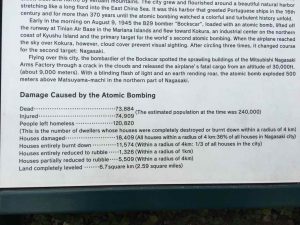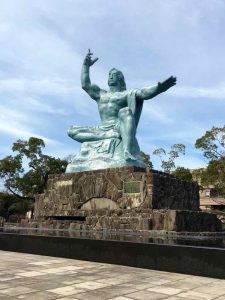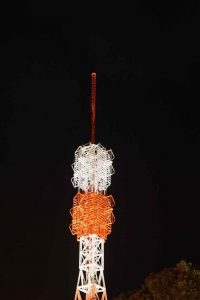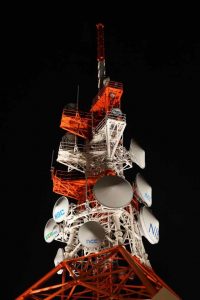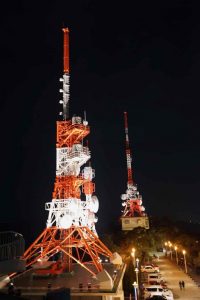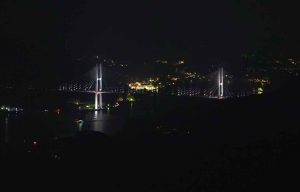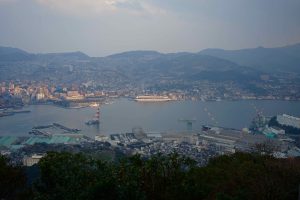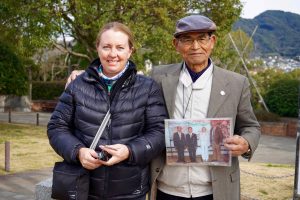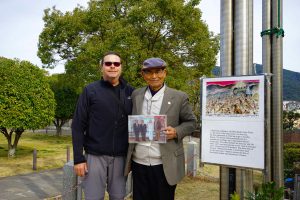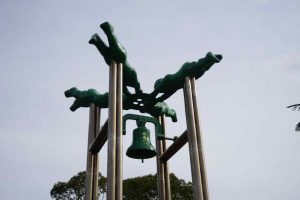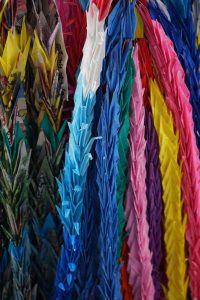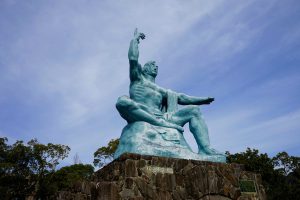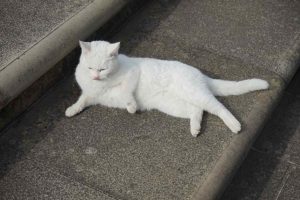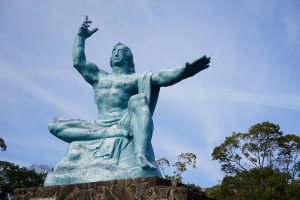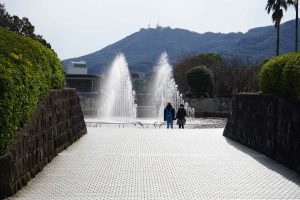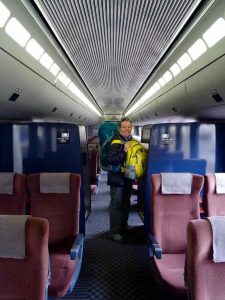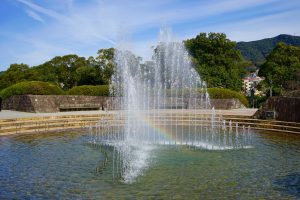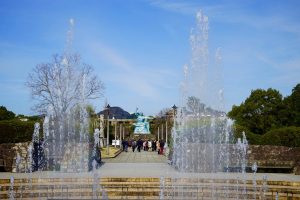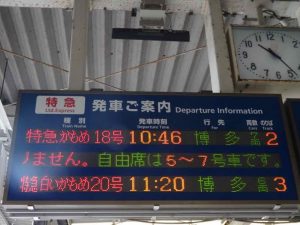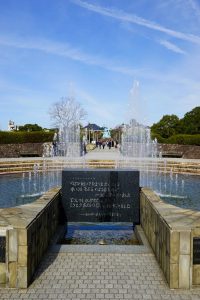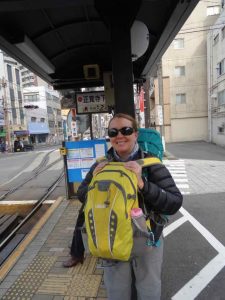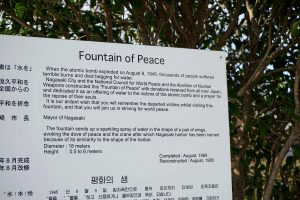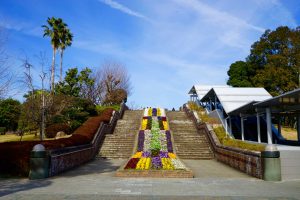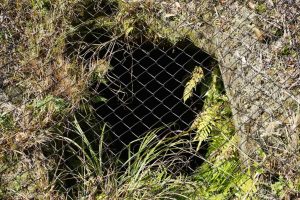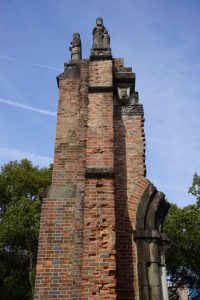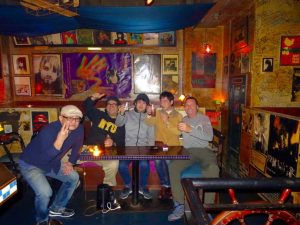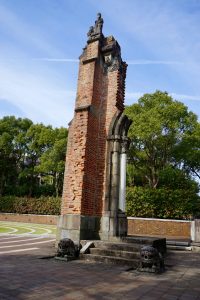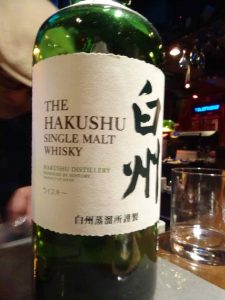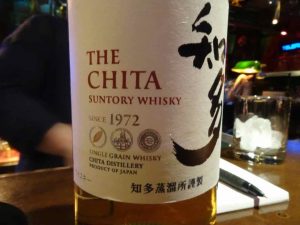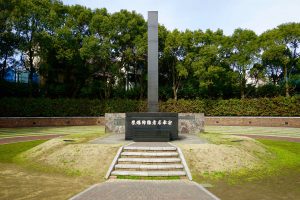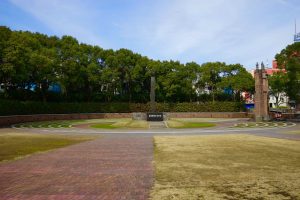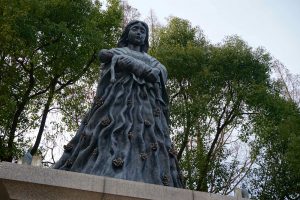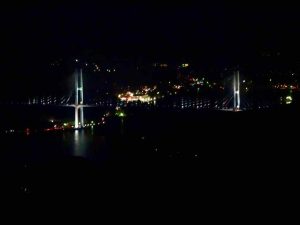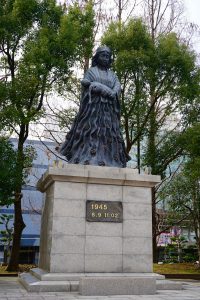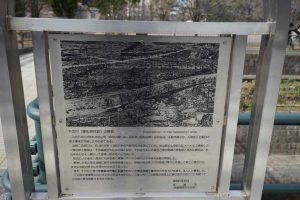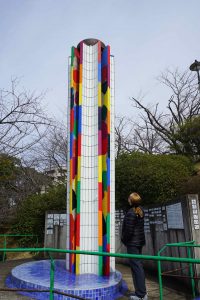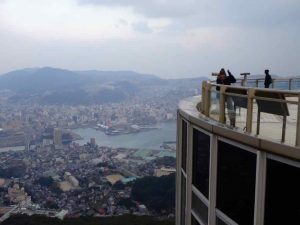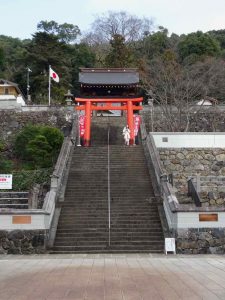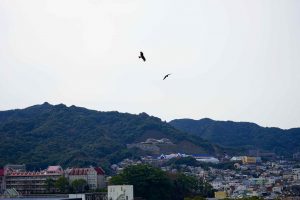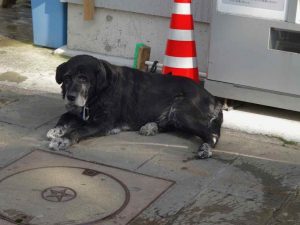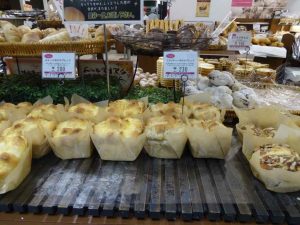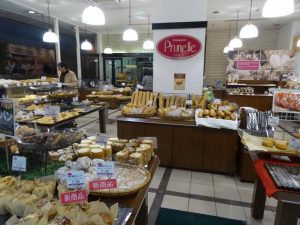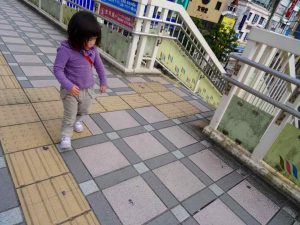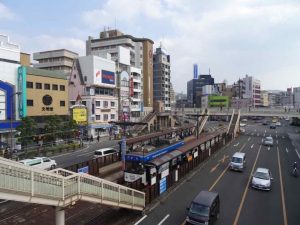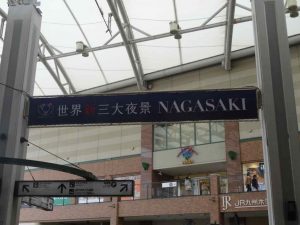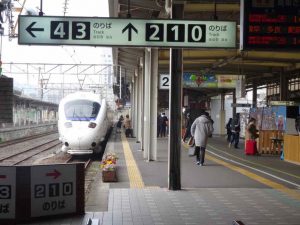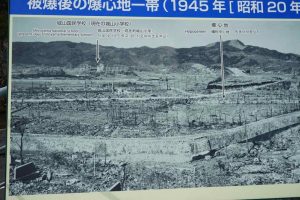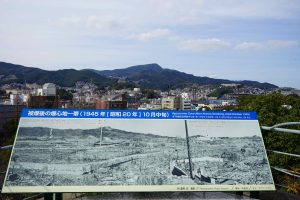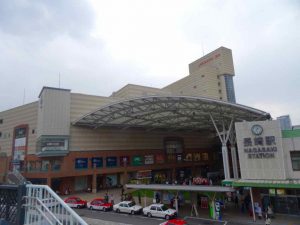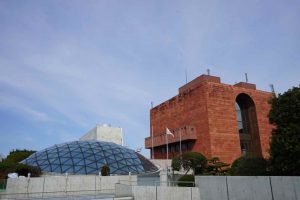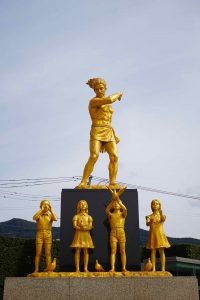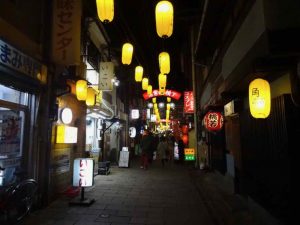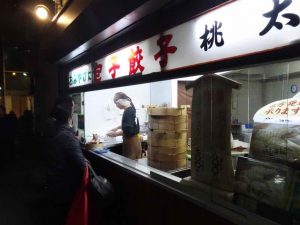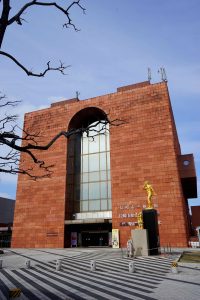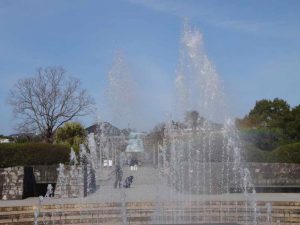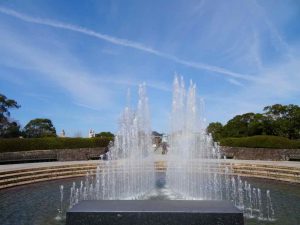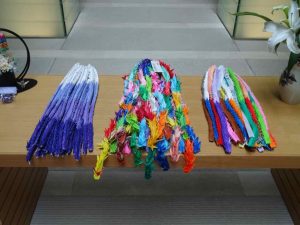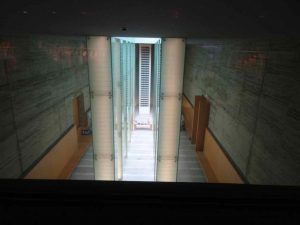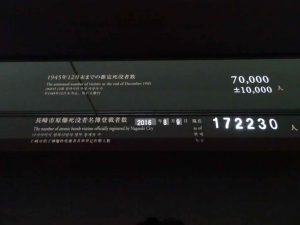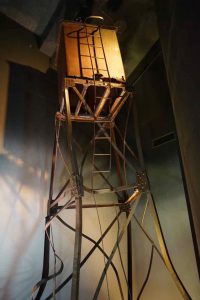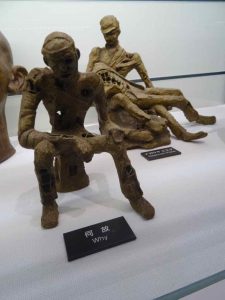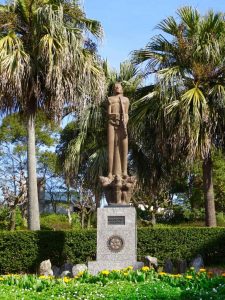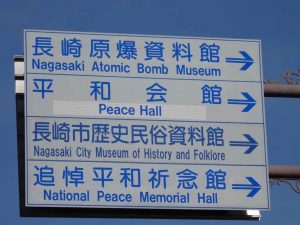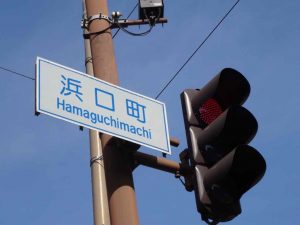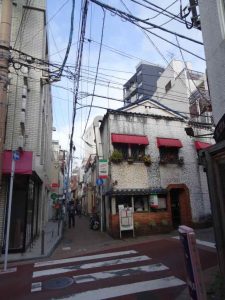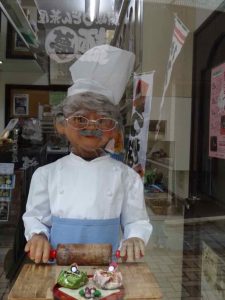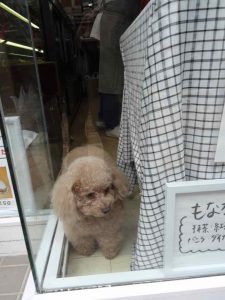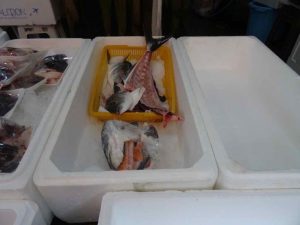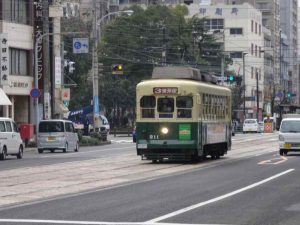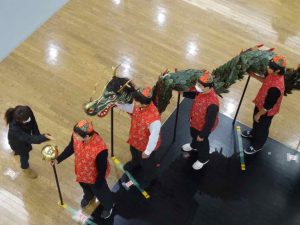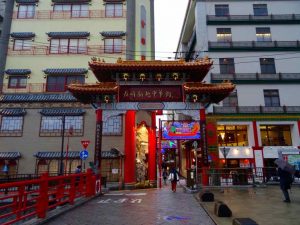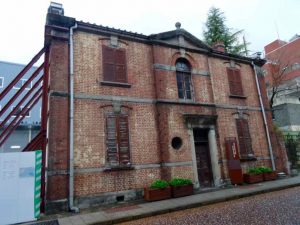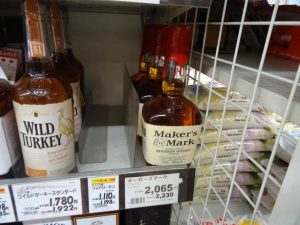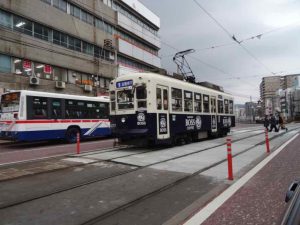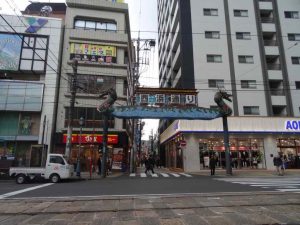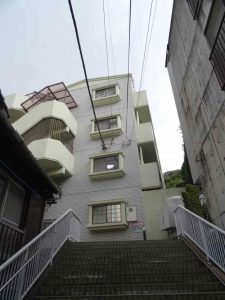We arrive in Nagasaki around 3 pm on Wednesday afternoon. I did not expect the city to be as mountainous or hilly. Nagasaki, a city of nearly half a million residents, sits on a large natural harbor, with the city beautifully terraced into the surrounding mountains and hillsides.
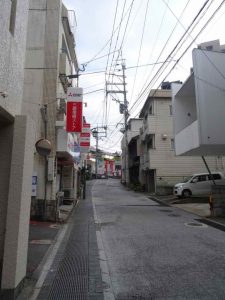
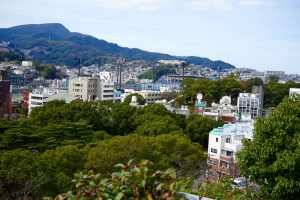 The streets in Nagasaki are narrow, at least the backstreets. And many of them are two way but barely wide enough for one car! I return the car to Toyota Car Rental and was glad to give it up!
The streets in Nagasaki are narrow, at least the backstreets. And many of them are two way but barely wide enough for one car! I return the car to Toyota Car Rental and was glad to give it up!
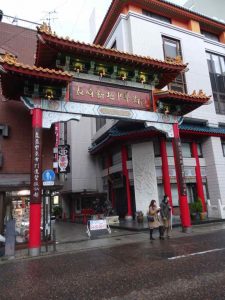
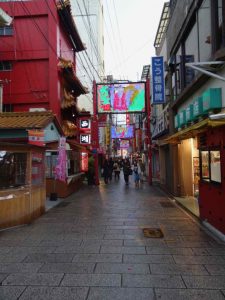 I walk about 25 minutes to our Nagasaki apartment, home for the rest of the week. Apparently there was a larger Chinese settlement here and there is a fairly large Chinatown. During Japan’s long history of isolation the Chinese where also restricted from trading, but apparently in practice they were not. Some architecture remains indicating the Chinese influence.
I walk about 25 minutes to our Nagasaki apartment, home for the rest of the week. Apparently there was a larger Chinese settlement here and there is a fairly large Chinatown. During Japan’s long history of isolation the Chinese where also restricted from trading, but apparently in practice they were not. Some architecture remains indicating the Chinese influence.
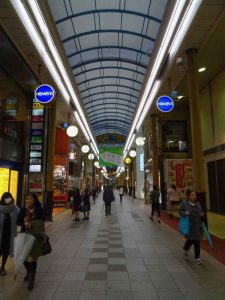
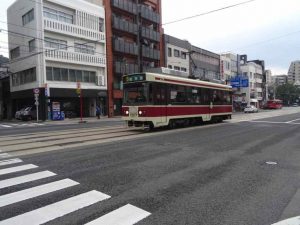 I also walk through large covered streets or “arcades” of shopping areas. The Hamanmachi area has hundreds of shops with everything from restaurants, department stores, grocery, to drugstores, salons and electronic stores. All of this is a few minutes walk from where we are staying. Nagasaki’s entertainment area, called Shianbashi is also near.
I also walk through large covered streets or “arcades” of shopping areas. The Hamanmachi area has hundreds of shops with everything from restaurants, department stores, grocery, to drugstores, salons and electronic stores. All of this is a few minutes walk from where we are staying. Nagasaki’s entertainment area, called Shianbashi is also near.
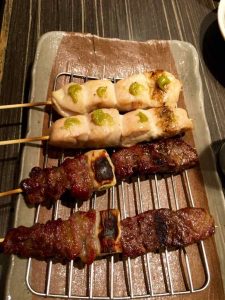
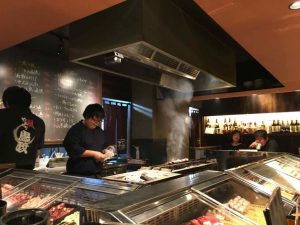 Tracey has quickly developed a liking for Yakitori and she picked a winner tonight. It was just about a one mile walk each way in the rain, but worth the walk to Torimasa Ebisu. We try the beef, chicken meatloaf with cheese, pork wrapped tomato with cheese, bacon wrapped asparagus, and chicken skin among others. I also enjoy Makers Mark on the rocks! I haven’t seen it in too many places, so I decided to pair it with the Yakitori. I usually drink local but I was tempted!
Tracey has quickly developed a liking for Yakitori and she picked a winner tonight. It was just about a one mile walk each way in the rain, but worth the walk to Torimasa Ebisu. We try the beef, chicken meatloaf with cheese, pork wrapped tomato with cheese, bacon wrapped asparagus, and chicken skin among others. I also enjoy Makers Mark on the rocks! I haven’t seen it in too many places, so I decided to pair it with the Yakitori. I usually drink local but I was tempted!
The rain picks up on the way home, two or three inches are predicted. No rain is forecast for the rest of the week so touring the area should be fine.
Thursday
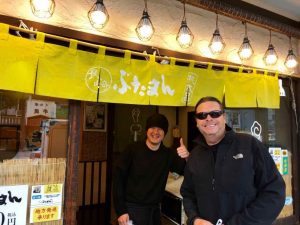 Today is cloudy and cool, the rain has stopped. We decide not to do the Atomic Bomb Museum and Peace Park today since we should get better pics tomorrow. Around 11:30 am we walked over to a “takeout” shop, Butaman Momotaro, famous for its dumplings, serving a bao bun and gyoza. It has been family run since 1960!
Today is cloudy and cool, the rain has stopped. We decide not to do the Atomic Bomb Museum and Peace Park today since we should get better pics tomorrow. Around 11:30 am we walked over to a “takeout” shop, Butaman Momotaro, famous for its dumplings, serving a bao bun and gyoza. It has been family run since 1960!
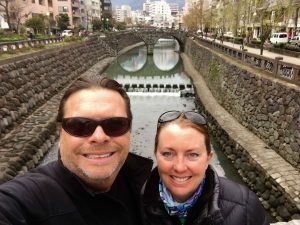
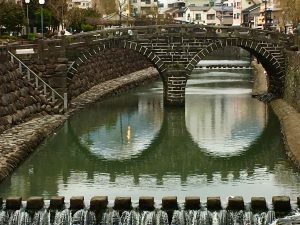 We eat these as we head to the Nagasaki Museum of History and Culture. En route we cross the river by the Spectacle Bridge, one of the most photographed places in Nagasaki. The bridge arches reflecting in the river resemble a pair of eye glasses.
We eat these as we head to the Nagasaki Museum of History and Culture. En route we cross the river by the Spectacle Bridge, one of the most photographed places in Nagasaki. The bridge arches reflecting in the river resemble a pair of eye glasses.
The museum covers Nagasaki’s history prior to WWI. Nagasaki was the only port in Japan beginning in 1639 that allowed interaction with other countries during part of the Edo period. The Edo period ran from 1603 to 1867. Limited relations were allowed with the Chinese and Dutch from Nagasaki.
The Edo period is when the Tokugawa shoguns ruled Japan. Neo-Confucianism was stressed and eventually schools that combined Shinto and Confucianist elements were developed. Christianity was persecuted beginning in 1614.
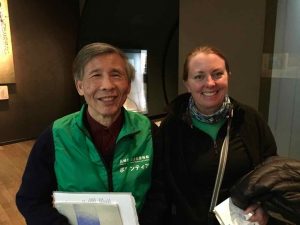 Just as we enter the museum area we are met by a volunteer guide. He asks where we are from and after a brief introduction, he tells us that his wife is a Nagasaki Atomic Bomb survivor. He tells us she has had two bouts with cancer during her life so far.
Just as we enter the museum area we are met by a volunteer guide. He asks where we are from and after a brief introduction, he tells us that his wife is a Nagasaki Atomic Bomb survivor. He tells us she has had two bouts with cancer during her life so far.
The volunteer, Yoshio Mitamura spends nearly three hours with us walking us through the exhibits. It is very helpful since there is some labeling in English, but he describes the exhibits and culture in more detail. His English is good enough to make the communication work! He is a retired banker who has a strong interest in history. I ask him how he understood so much history. Growing up he says, he was always reading history when on breaks from school.
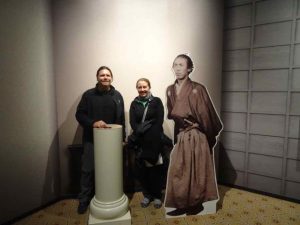 During our time together we are able to share some candid perspectives on everything from Pearl Harbor, the conditioning of the Japanese people by its government to drive war, the atomic bombs, and, yes, even Donald Trump. Yoshio describes the culture of Japan as he so kindly works to understand our questions. We are so grateful for his kindness and time that has made our visit so special here at the museum. He also suggests we try Castella, a Japanese sponge cake inspired by Portuguese missionaries, in the 16th century. The cake is made of eggs, flour, and sugar. So he says “not too much” as the “blood sugar will spike”, lol.
During our time together we are able to share some candid perspectives on everything from Pearl Harbor, the conditioning of the Japanese people by its government to drive war, the atomic bombs, and, yes, even Donald Trump. Yoshio describes the culture of Japan as he so kindly works to understand our questions. We are so grateful for his kindness and time that has made our visit so special here at the museum. He also suggests we try Castella, a Japanese sponge cake inspired by Portuguese missionaries, in the 16th century. The cake is made of eggs, flour, and sugar. So he says “not too much” as the “blood sugar will spike”, lol.
We head home around 4 pm walking through some of the narrow streets filled with shops and restaurants. I could spend a lot of time here for sure! We get a bit of rest before heading out to explore Nagasaki and more culinary delights.
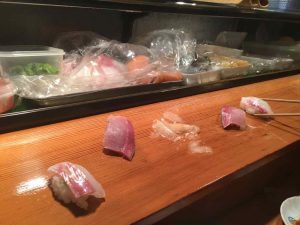 About 7 pm we travel just 400 meters, about six minutes to a small neighborhood sushi bar, 三和鮨. There are only about 6 or 8 stools at the sushi bar. No English spoken, so the chef and owner of the establishment just starts serving us sushi. We have about everything he has in the case – yellowtail, eel, sea urchin, salmon, salmon roe, California roll, and a few things we don’t recognize. All of these with hot tea.
About 7 pm we travel just 400 meters, about six minutes to a small neighborhood sushi bar, 三和鮨. There are only about 6 or 8 stools at the sushi bar. No English spoken, so the chef and owner of the establishment just starts serving us sushi. We have about everything he has in the case – yellowtail, eel, sea urchin, salmon, salmon roe, California roll, and a few things we don’t recognize. All of these with hot tea.
An older gentlemen comes in and eats, sharing his beer with the chef, kanpai! A middle-aged lady comes in and sits next to me. She asks where we are from and we share our story. She is amazed and excited about all the places we have visited in Kyushu, including the volcanoes. She is able to translate our story to the chef and he seems excited to be able to communicate more with us. He insists that we take an English chart with us that describes the various fish and where they are sourced. Such wonderful people!
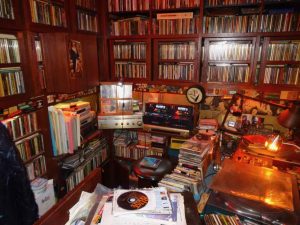
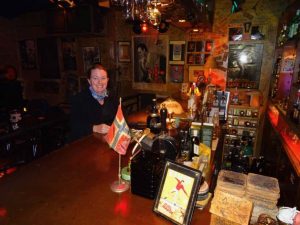 Just a block away is Panic Paradise, a Pub we stop by for a nightcap, or two. And paradise it is! It is a basement bar filled with thousands of records and CDs, guitars hanging on the walls and around the room, ready to be played. There is a full bar in this cozy place and absolutely great music.
Just a block away is Panic Paradise, a Pub we stop by for a nightcap, or two. And paradise it is! It is a basement bar filled with thousands of records and CDs, guitars hanging on the walls and around the room, ready to be played. There is a full bar in this cozy place and absolutely great music.
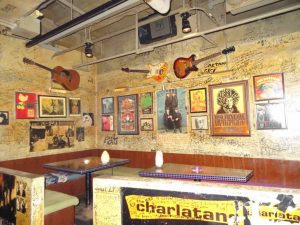 Seiji, the owner speaks English, pretty well. We eyed a CD cover of the J. Geils band in amazement. He immediately walks over to shelves with thousands of records and CDs and pulls J Geils out and starts playing it. (Somewhat ironic as J. Geils had just died as of this writing in April 2017.)
Seiji, the owner speaks English, pretty well. We eyed a CD cover of the J. Geils band in amazement. He immediately walks over to shelves with thousands of records and CDs and pulls J Geils out and starts playing it. (Somewhat ironic as J. Geils had just died as of this writing in April 2017.)
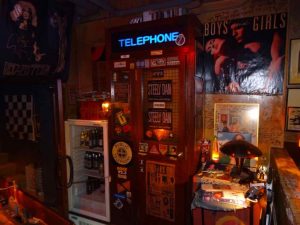 The bar is definitely well established, with posters of every US and most worldwide rock musicians from the 1950s to the 1990s filling every available spot on the walls. We hope to be back here Friday and or Saturday night!
The bar is definitely well established, with posters of every US and most worldwide rock musicians from the 1950s to the 1990s filling every available spot on the walls. We hope to be back here Friday and or Saturday night!
Friday
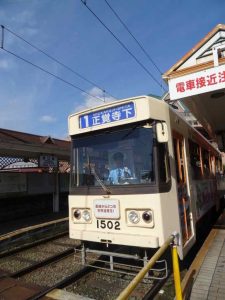 It is a cold but sunny morning as we head out to what will surely be a somber day. We are going to the Nagasaki Atomic Bomb Museum, Peace Park and Memorial. We catch the street car just a couple of minutes from our apartment. It is toward the end of rush hour so it is not too crowded. It is a short walk to the museum at the Hamaguchimachi station.
It is a cold but sunny morning as we head out to what will surely be a somber day. We are going to the Nagasaki Atomic Bomb Museum, Peace Park and Memorial. We catch the street car just a couple of minutes from our apartment. It is toward the end of rush hour so it is not too crowded. It is a short walk to the museum at the Hamaguchimachi station.
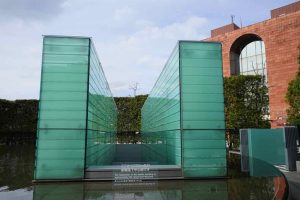 Right as you enter the entrance at the museum, the letter to Japan from President Obama is displayed from his 2016 visit to Hiroshima. A welcome gesture.
Right as you enter the entrance at the museum, the letter to Japan from President Obama is displayed from his 2016 visit to Hiroshima. A welcome gesture.
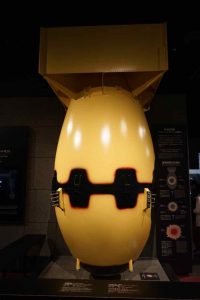
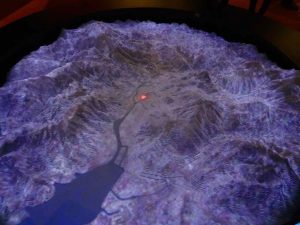 The museum is a somber place that thoroughly recounts events, bombing, and Nagasaki’s destruction and loss of life. There is so much on display, photos and artifacts that show the utter devastation from the pressure, thousands of degree heat, and the radiation related deaths and injuries. There are mangled clocks on display that show the moment of the bomb, with the clock hands stopped at 11.02 am.
The museum is a somber place that thoroughly recounts events, bombing, and Nagasaki’s destruction and loss of life. There is so much on display, photos and artifacts that show the utter devastation from the pressure, thousands of degree heat, and the radiation related deaths and injuries. There are mangled clocks on display that show the moment of the bomb, with the clock hands stopped at 11.02 am.
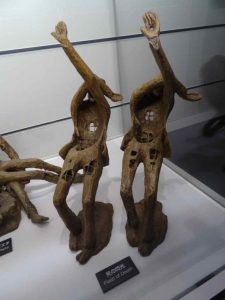
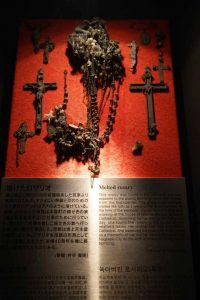 There are many stories of the lives impacted, as well as survivors stories. Exhibits include the current state of nuclear escalation, testing and disarmament efforts…which are distributing.
There are many stories of the lives impacted, as well as survivors stories. Exhibits include the current state of nuclear escalation, testing and disarmament efforts…which are distributing.
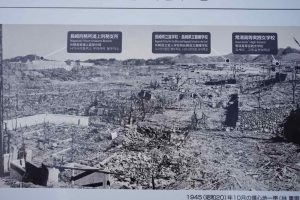 The events are well documented that describe how Japan’s government spent years conditioning Japan’s people by restricting and delegitimizing the press, creating nationalism, increasing its military, an education system stressing national unity, and devotion to the emperor. Citizens of Japan were beginning to realize that their government was being deceptive and support for war was quickly diminishing. Regardless of whether one thinks the Nagasaki and Hiroshima bombings were necessary to end the war (and there are many sides and perspectives to this), one walks away understanding that peace must be pursued to no end and that nuclear weapons should never, ever, be used again.
The events are well documented that describe how Japan’s government spent years conditioning Japan’s people by restricting and delegitimizing the press, creating nationalism, increasing its military, an education system stressing national unity, and devotion to the emperor. Citizens of Japan were beginning to realize that their government was being deceptive and support for war was quickly diminishing. Regardless of whether one thinks the Nagasaki and Hiroshima bombings were necessary to end the war (and there are many sides and perspectives to this), one walks away understanding that peace must be pursued to no end and that nuclear weapons should never, ever, be used again.
The related vision and values are pervasive here in Nagasaki. A cab driver tells us the number one priority in Japan is peace, number two, safety. The people here we have met so far are so kind, so respectful.
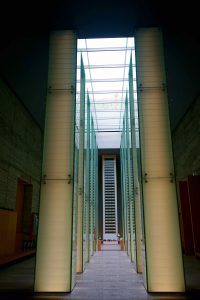
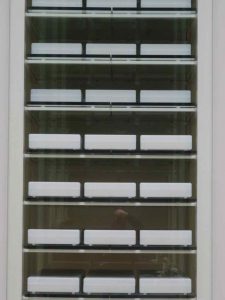 We move to Memorial Hall just next to the Atomic Bomb Museum. The Memorial Hall is minimalist in design. There are 12 glass pillars lit by the sky as they reach skyward. There are shelves of books of the names of the deceased. Very serene and most impactful.
We move to Memorial Hall just next to the Atomic Bomb Museum. The Memorial Hall is minimalist in design. There are 12 glass pillars lit by the sky as they reach skyward. There are shelves of books of the names of the deceased. Very serene and most impactful.
Hypocenter and the Peace Park
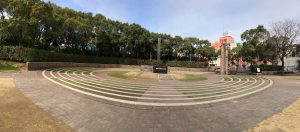 We exit the Hall and walk over to the “Hypocentre”, the point over Nagasaki where the A Bomb exploded. It is a surreal feeling at this place imagining what occurred over 70 years ago.
We exit the Hall and walk over to the “Hypocentre”, the point over Nagasaki where the A Bomb exploded. It is a surreal feeling at this place imagining what occurred over 70 years ago.
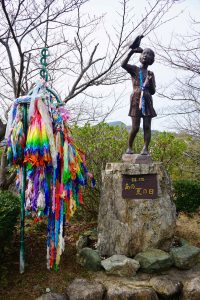
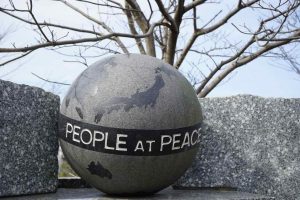 There are numerous memorials from countries around the world throughout the area.
There are numerous memorials from countries around the world throughout the area.
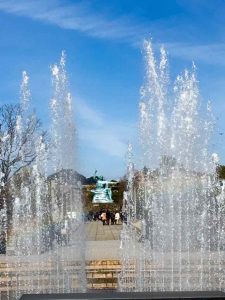
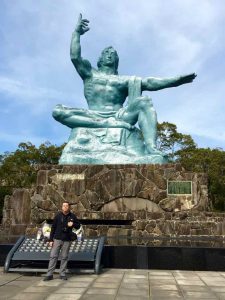 From here we go to the Peace Park. At the far end of the park is a towering 10-ton bronze Peace Statue. There is also a beautiful dove shaped fountain of peace. Water is sprayed in the shape of the wings of a dove or crane. People place flowers and “Senbazuru” (Thousand paper cranes on a string), a symbol of peace and longevity in Japan, in memory of those who lost their lives.
From here we go to the Peace Park. At the far end of the park is a towering 10-ton bronze Peace Statue. There is also a beautiful dove shaped fountain of peace. Water is sprayed in the shape of the wings of a dove or crane. People place flowers and “Senbazuru” (Thousand paper cranes on a string), a symbol of peace and longevity in Japan, in memory of those who lost their lives.
The inscription for the Peace Statue written by the sculptor Seibo Kitamura in 1955 reads:
After experiencing that nightmarish war, that blood-curdling carnage, that unendurable horror. Who could walk away without praying for peace? The statue was created as a signpost in the struggle for global harmony. Standing 10m tall, it conveys the profundity of knowledge and the beauty of health and virility. The right hand points to the atomic bomb, the left hand points to peace, and the face prays deeply for the victims of war. Transcending the barriers of race and evoking the qualities of both Buddha and God, it is a symbol of the greatest determination ever known in the history of Nagasaki and of the highest hope of all mankind. ~ Seibo Kitamura, Sculptor. 1955
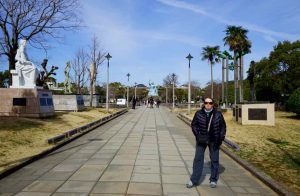
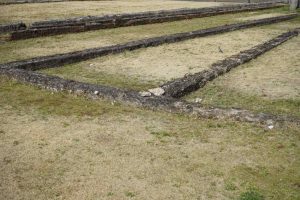 At the time of the bombing, the Peace Park was the site of the Urakami Prison. All employees and prisoners were instantly killed in the bombing. Part of the foundation eerily remains.
At the time of the bombing, the Peace Park was the site of the Urakami Prison. All employees and prisoners were instantly killed in the bombing. Part of the foundation eerily remains.
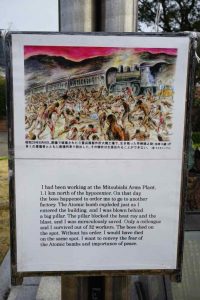
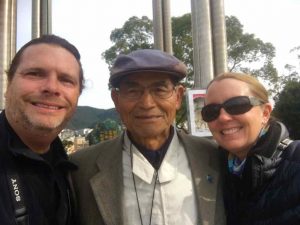 We did a fair amount of reading prior to our visit regarding the war, the events leading to the bombing, and stories of survivors. As we were leaving the park, we run into a survivor that was there that day in August 1945. He tells us his story and does his best with English. We put our arms around one another in a brief connection that is so moving. His story and why he still works for peace:
We did a fair amount of reading prior to our visit regarding the war, the events leading to the bombing, and stories of survivors. As we were leaving the park, we run into a survivor that was there that day in August 1945. He tells us his story and does his best with English. We put our arms around one another in a brief connection that is so moving. His story and why he still works for peace:
“I had been working at the Mitsubishi arms plant,1.1 km north of the hypocenter. On that day the boss happened to order me to go to another factory. The atomic bomb exploded just as I entered the building. I was blown behind a big pillar, which blocked the heat ray and the blast. I was miraculously saved. Only a colleague and I survived, out of 32 workers. The boss died on the spot. I want to convey the fear of the atomic bomb.” – Nagasaki atomic bomb survivor, Inosuke Hayasaki.
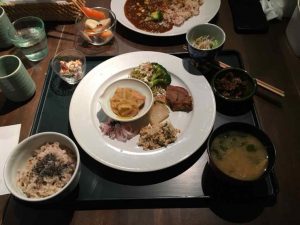 Emotionally drained, we head back to our Nagasaki apartment for a brief rest. Dinner tonight is at Organic Tia restaurant. They serve us excellent vegetarian and organic Japanese food!
Emotionally drained, we head back to our Nagasaki apartment for a brief rest. Dinner tonight is at Organic Tia restaurant. They serve us excellent vegetarian and organic Japanese food!
We head back to our local pub, Passion Paradise to see Seiji, the owner. We spend the evening and early morning hours here with several new Japanese friends laughing, talking, translating, and listening to music. They teach us Japanese and we share some “Australian English” with them, lol. A beautiful “night” with great people.
Saturday
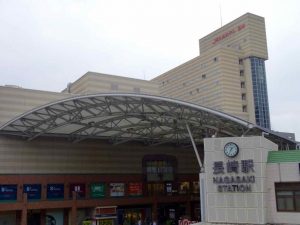
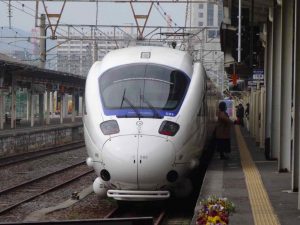 On Saturday we head to the Nagasaki Train station to activate our 21 day JR Rail Pass. The pass is good for unlimited travel by visitors through Japan including travel on the Shinkansen, Japan’s “bullet train”. The Shinkansen travels at speeds of nearly 200 mph.
On Saturday we head to the Nagasaki Train station to activate our 21 day JR Rail Pass. The pass is good for unlimited travel by visitors through Japan including travel on the Shinkansen, Japan’s “bullet train”. The Shinkansen travels at speeds of nearly 200 mph.
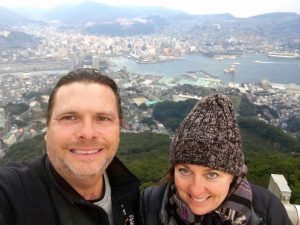
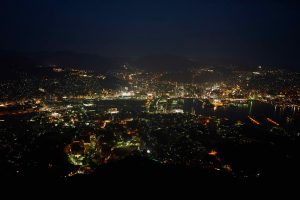 The night view over Nagasaki from Mount Inasa, 333 meter high mountain is considered by many as one of the best “night views” in the world. The mountain is about a 20 minute ride by taxi from Nagasaki’s city center. The summit can also be reached by cable car or “ropeway” as it is referred to in Japan. We head here for sunset and the night view…beautiful!
The night view over Nagasaki from Mount Inasa, 333 meter high mountain is considered by many as one of the best “night views” in the world. The mountain is about a 20 minute ride by taxi from Nagasaki’s city center. The summit can also be reached by cable car or “ropeway” as it is referred to in Japan. We head here for sunset and the night view…beautiful!
We move on to dinner at Hamakatsu for some katsudon. This is great, filling, comfort food on a cold night in the 30s! It is a feast of deep fried pork and chicken cutlets with rice, cabbage, miso and hot tea. There are several condiments including sesame seeds that we crush with a mortar and petula and then mix with a sauce for dipping the pork. Outstanding!
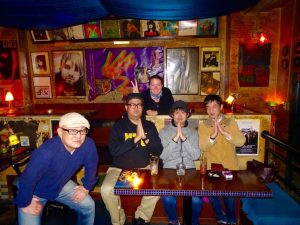 We head back to Panic Paradise for a nightcap and to say sayonara to our Nagasaki friends. What a wonderful city that we love!
We head back to Panic Paradise for a nightcap and to say sayonara to our Nagasaki friends. What a wonderful city that we love!
Sunday we are up and ready to “Bullet Train” it to new adventures in Hiroshima!
